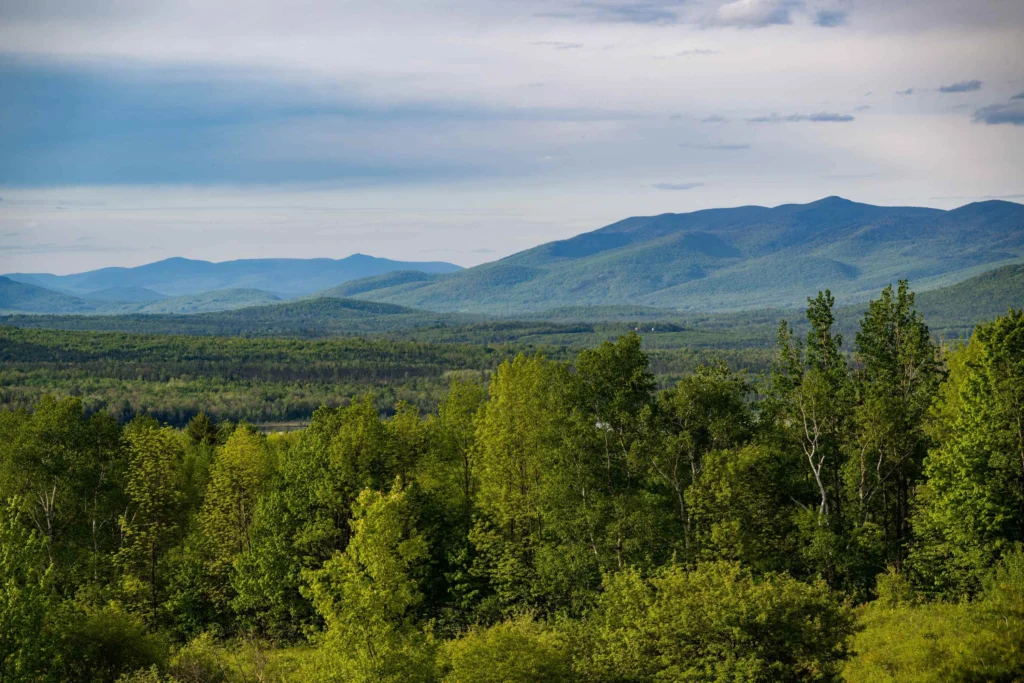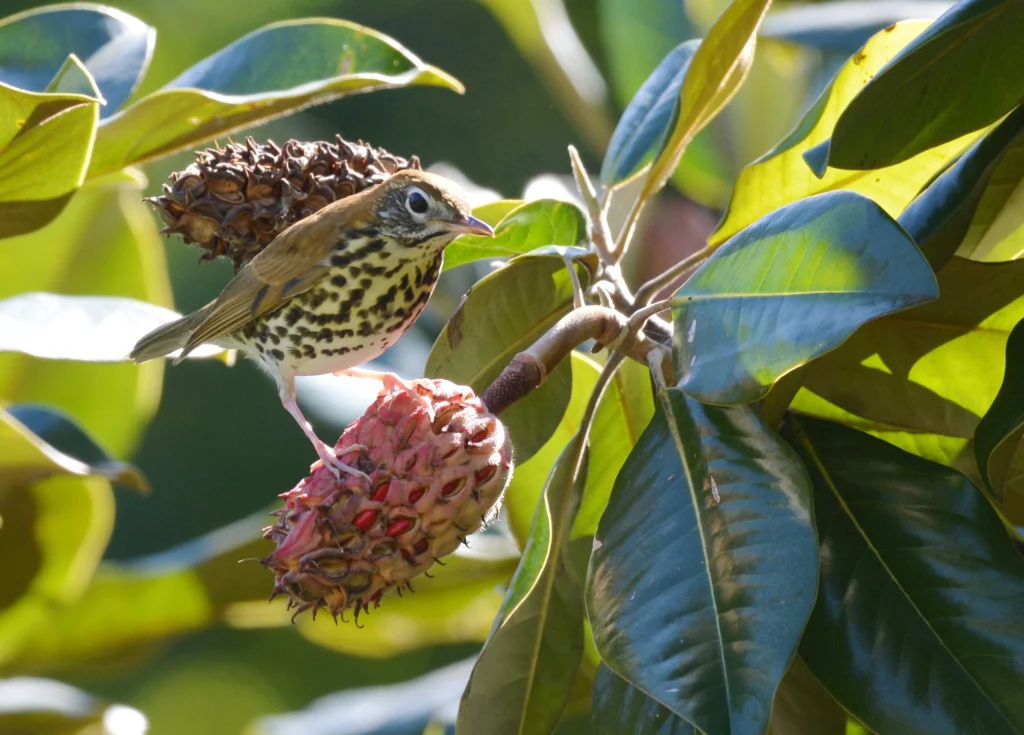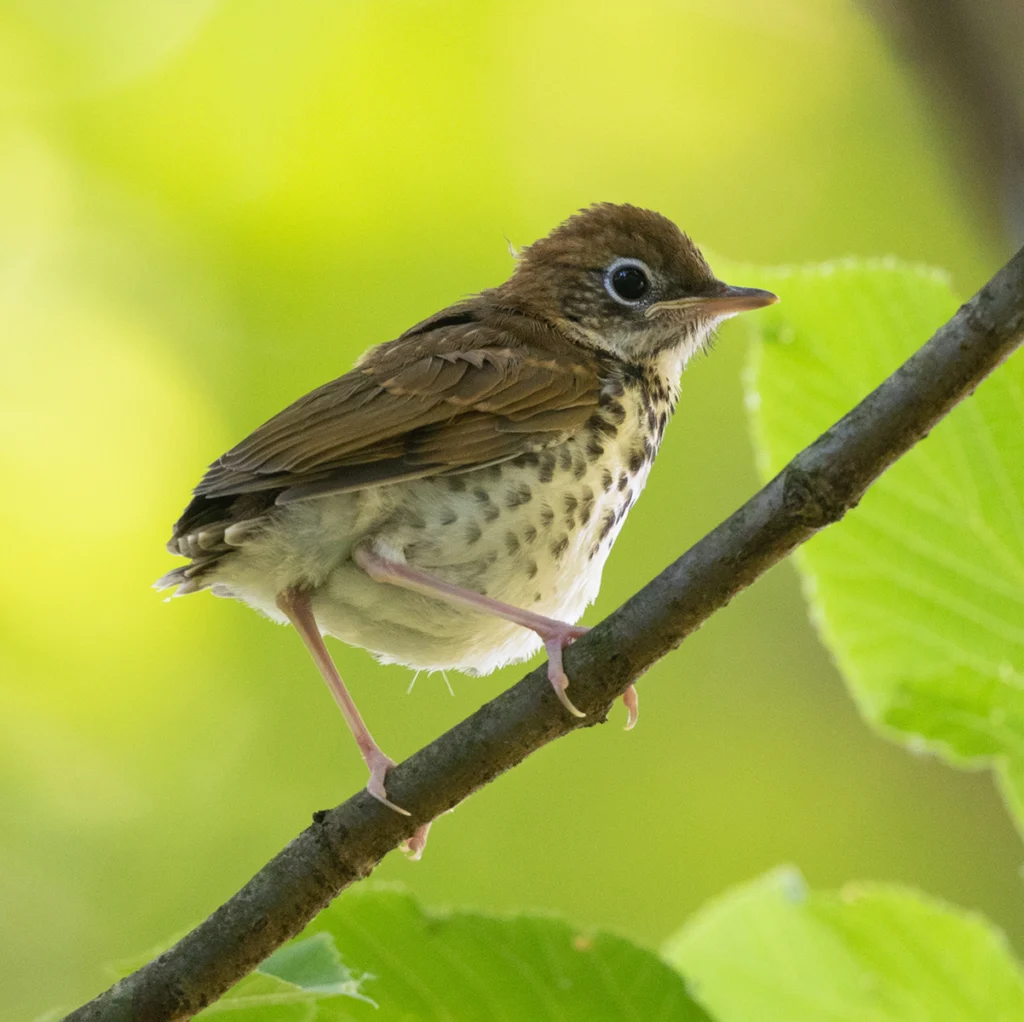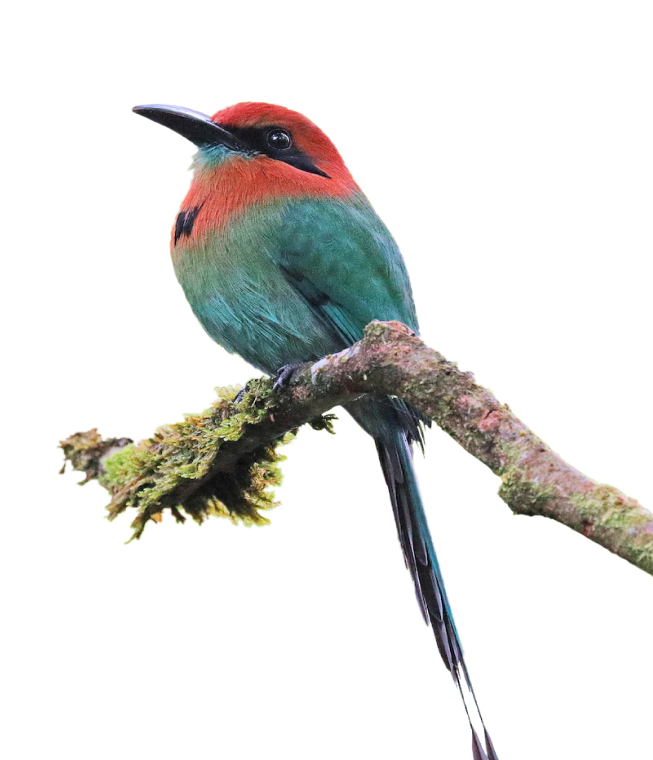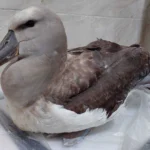
Overview
About
The robust, long-legged Wood Thrush is closely related to the American Robin and thrushes of the genus Catharus, such as the Bicknell’s Thrush and Swainson’s Thrush. Its scientific name, Hylocichla mustelina, translates roughly as “weasel-colored woodland thrush,” a reference to this bird’s rich red-brown head, back, wings, and tail.
The Wood Thrush’s haunting, flute-like song is made possible by some very specialized anatomy. Like all songbirds, Wood Thrushes have a Y-shaped voice box, called a syrinx. During his three-part song, a male Wood Thrush actually sings pairs of notes simultaneously, which harmonize and blend to produce ringing, ethereal tones. An individual bird can sing unique versions of each song part, and one male Wood Thrush can easily sing more than 50 distinct songs!
Threats
Partners in Flight places the Wood Thrush on its Yellow Watch List of declining birds, noting a 60-percent drop in its population between 1970 and 2014. In addition, the Wood Thrush is considered a Tipping Point species: one that has lost more than 50 percent of its population within the past 50 years.
Habitat Loss
Wood Thrushes thrive in large, unbroken forest tracts, and the destruction, fragmentation, and poor management of forests on their breeding and nonbreeding grounds are major factors in their decline. Wood Thrushes will also attempt to nest in well-wooded suburban areas, but in these places their nests are more vulnerable to predation from corvids, raccoons, and domestic cats. Here, they are also more at risk from nest parasitism by Brown-headed Cowbirds, who lay their eggs in the nests of other species — a reproductive strategy that was useful for nomadic cowbirds following cattle on the Great Plains centuries ago, but has become a problem for other species as the cowbird’s range has expanded due to landscape alteration by humans.
Glass Collisions
The Wood Thrush is a frequent victim of fatal collisions with human-made structures such as glass windows and buildings, communications towers, and wind turbines.
Pesticides & Toxins
Acid rain decreases soil pH, resulting in decreased calcium content in the soil and less calcium-rich invertebrate prey, such as snails, available for the Wood Thrush.
Cats & Invasive Species
Invasive species, including domestic cats, are the leading human-caused driver of bird population declines. Wood Thrushes and other songbirds are common victims of free-roaming cats.
Conservation Strategies & Projects
Birds need our help to overcome the threats they face. At ABC, we’re inspired by the wonder of birds and driven by our responsibility to find solutions to meet their greatest challenges. With science as our foundation, and with inclusion and partnership at the heart of all we do, we take bold action for birds across the Americas.
Creating & Maintaining Reserves
Habitat protection and restoration in all areas of its life cycle are the key to effective Wood Thrush conservation. On its eastern U.S. breeding grounds, ABC is working with partners in the Appalachian Mountains, Central Hardwoods, and other Joint Ventures to manage thousands of acres of forests for this thrush’s benefit.
Throughout Latin America and the Caribbean, we are working with dozens of partners and local communities to create and support a growing network of protected areas where this species and other Neotropical migratory birds can safely spend the nonbreeding season. Our BirdsPlus program helps farmers and ranchers apply conservation practices to working lands that will restore and maintain habitat for Wood Thrush and other migratory birds.
Preventing Glass Collision
ABC has been a leader in the effort to reduce the devastating toll of glass collisions on birds. We’ve developed innovative methods for evaluating the effectiveness of collision deterrents, created resources to elevate our collective understanding of collisions and make solutions readily accessible, and advocated for bird-friendly policies in the U.S.
Avoiding Pesticides & Toxins
ABC works with partners at the state and federal levels in the U.S. to call for the regulation or cancellation of the pesticides and toxins most harmful to birds. We develop innovative programs, like working directly with farmers to use neonicotinoid coating-free seeds, advance research into pesticides’ toll on birds, and encourage millions to pass on using harmful pesticides.
Keeping Cats Indoors
Although cats make wonderful companions, they’re safest (and birds are, too) when they’re kept indoors or under the control of their owners. ABC advocates for responsible cat ownership, encouraging millions of pet owners to take steps to keep their cats contained and advocating for policies that benefit birds, cats, and human health.
Bird Gallery
The Wood Thrush is the largest of North America’s spotted thrushes, with an upright posture very much like that of its larger relative, the American Robin. Adults are a warm cinnamon-brown on the crown and nape, fading to duller olive-brown on the back, wings, and tail. The face has a conspicuous white eyering, and the clean white underside is covered in large black spots. Long pink legs and large dark eyes are also conspicuous, and characteristic of a bird species that spends much of its time foraging on the ground in dimly-lit forest interiors.
Juvenile Wood Thrushes resemble adults, but have heavy buff edging on their wing feathers, which they lose after their first winter.
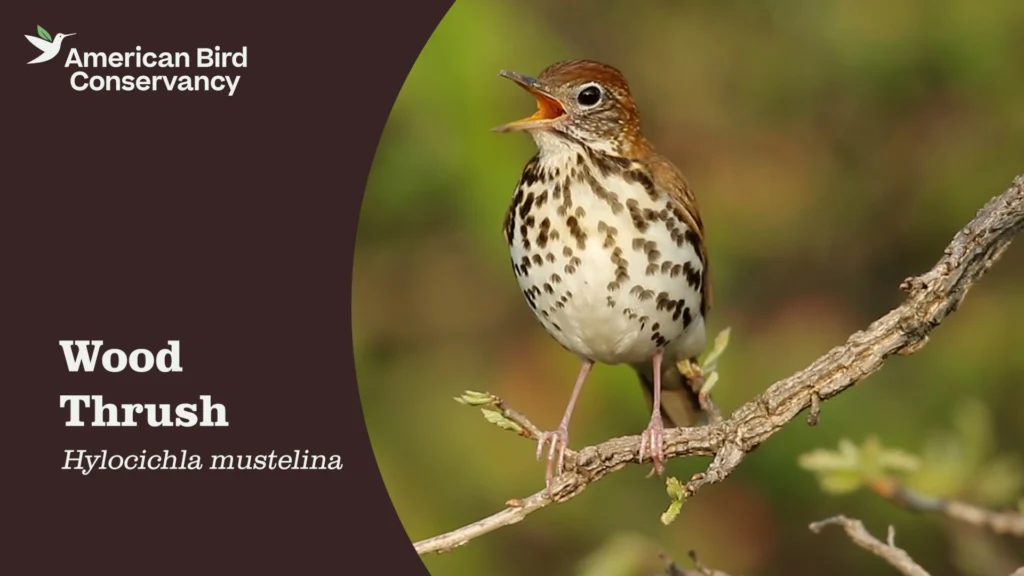
Bird Sounds
The Wood Thrush’s complex song begins with several low, almost inaudible notes, followed by the rising, flute-like ee-oh-lay, finishing with a complex trill. Another commonly heard vocalization is a rapid pit-pit-pit call, given by both sexes. This series is heard year-round, including at dusk, as one of the last sounds these birds make before roosting.
Jonathon Jongsma, XC105133. Accessible at www.xeno-canto.org/105133.
Orlando Jarquín G., XC308317. Accessible at www.xeno-canto.org/308317.
Habitat
The Wood Thrush is the quintessential forest bird both on its breeding territory and its nonbreeding grounds. breeds in mature deciduous and mixed forests.
- Breeds in mature deciduous and mixed forests, preferring those with American beech, sweet gum, oaks, or pines that are ideally 50 feet tall
- Fares best in contiguous forests, but will attempt to breed in fragmented forests or even small parks with sufficient tree cover
- In the nonbreeding season, found in tropical lowland and foothill forests and second-growth forests and edges, including
shade coffee or cacao plantations

Range & Region

Specific Area
Eastern North America, Central America
Range Detail
The Wood Thrush breeds in deciduous and mixed forests of eastern North America, from southern Canada to northern Florida, and from the Atlantic coast to the eastern Great Plains. Each fall, they migrate south to Mexico and Central America, mainly in the humid lowland forests along the Atlantic and Pacific coasts.
Did you know?
Like the Great Crested Flycatcher, Red-eyed Vireo, and Scarlet Tanager, the Wood Thrush is a long-distance, nocturnal migratory species, journeying from Central America over the open ocean to the southern United States and back again during its travels.
Life History
Wood Thrushes are most easily spotted shuffling about on the forest floor, kicking and picking through leaf litter for insects. These seasonally monogamous birds nest in young trees or shrubs, timing their arrival on their breeding grounds with the emergence of insects, snails, and salamanders.
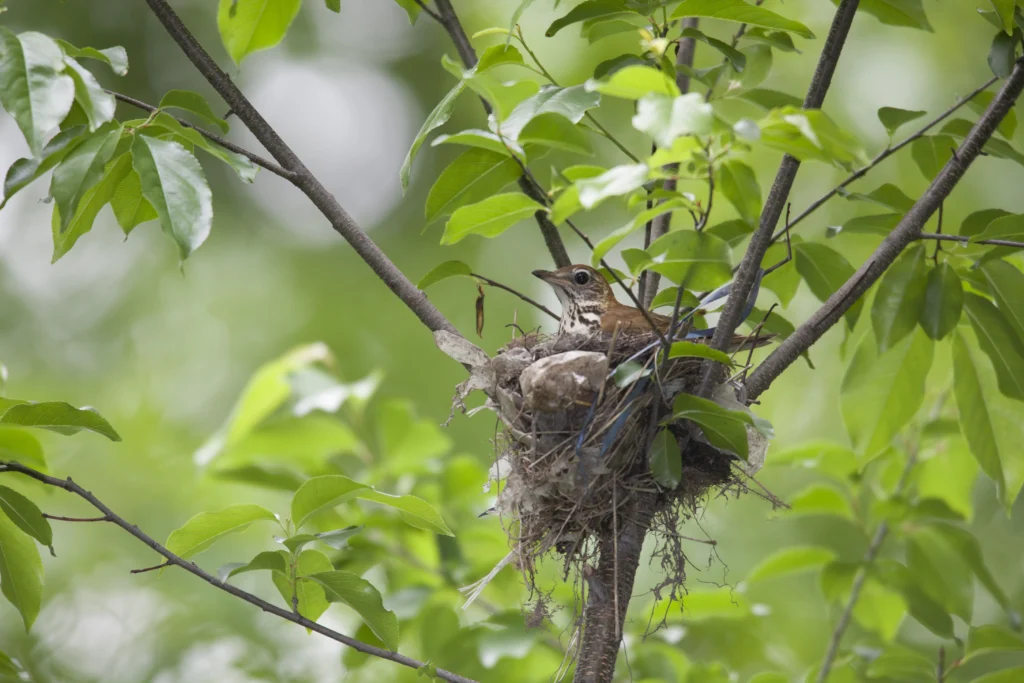
Diet
The Wood Thrush forages mainly on the ground, flipping over leaves in search of insects, snails, and sometimes small salamanders in the manner of a Kentucky Warbler or Eastern Towhee. It will also eat small fruits, including dogwood, holly, and pokeweed berries, especially in the late summer and fall, while building up fat to fuel its migratory treks.
Calcium-rich materials such as snail shells are particularly important to female Wood Thrushes, which need this mineral to successfully develop a clutch of eggs. Snails have declined in forested habitats due to the effects of acid rain, perhaps another driver of Wood Thrush population declines.
Courtship
The male Wood Thrush arrives on the breeding grounds first, staking out a territory of up to several acres. The female arrives several days later, and the pair court in a series of circular flights and mutual feeding sessions.
Wood Thrushes are seasonally monogamous, meaning a pair will stay together for the duration of one breeding cycle. However, extra-pair copulation is common, and up to 40 percent of a female’s young may not be fathered by her mate! This breeding strategy likely promotes greater genetic diversity in the young.
Nesting
The female Wood Thrush chooses a nest site, usually in a young tree or shrub less than 20 feet above the ground. Like an American Robin, she incorporates a layer of mud into her bulky, cup-shaped nest. Interestingly, while the outside of the nest is usually made of dead grasses, some thrushes may add paper, cellophane, cloth, or other white materials. The contrasting color is thought to help break up the nest’s contour, making it less obvious to potential predators.
Eggs & Young
The female Wood Thrush lays a clutch of three or four blue-green eggs, which she incubates herself for approximately two weeks. Her mate will sometimes bring her food as she broods, and pitches in to help feed the nestlings after they hatch.
Because the male Wood Thrush helps feed the young, the female has time to start a second nest. Almost half of all mated pairs raise two broods, ranging in size from two to four chicks.
Unfortunately, this species often ends up raising the young of Brown-headed Cowbirds, a species that lays eggs in the nests of other birds. While this once freed up cowbirds to follow herds of cattle and bison and the insects they kicked up, humans have remade much of the landscape, and the cowbird’s range has greatly expanded. Other songbirds raise cowbirds’ often much larger young, sometimes at the expense of their own offspring.
